On a bright spring day, the artist Younès Rahmoun is showing me around his home town of Tétouan, a city in Morocco at the foot of the Rif mountains. Inside the medina – the old walled area and a Unesco world heritage site – he spots a bead on the ground. It’s small, plastic and the least interesting thing I can see. Nearby, men in striped, hooded djellabas sell spices while women in traditional Berber straw hats walk past. But in Rahmoun’s art – which has been nominated for the Victoria and Albert Museum’s Jameel prize – simple objects such as this bead can contain worlds of meaning.
The 43-year-old is dressed in an understated style – muted grey checked shirt and baseball cap – but talks like a mystic, seeking signs in everything. He is one of Morocco’s most important artists, but is unassuming, apologising for his (excellent) English as he looks for the words to explain how his spiritual life informs his work.
“I have questions,” he says. “Not just about religion, but also existence. About the relationship between me and the cosmos, me and other people, me and nature.”
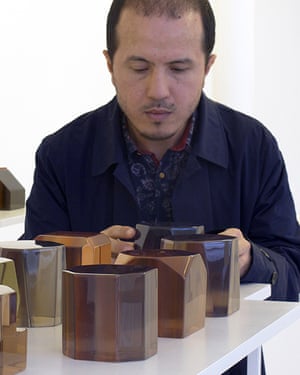
Rahmoun is fascinated by Zen Buddhism and Sufism, the esoteric aspect of Islam that emphasises spirituality and divine love. The Jameel prize is for contemporary art inspired by Islamic artistic traditions, and geometric patterns, certain numbers and shapes recur in Rahmoun’s work. Beads or marbles capture his imagination because the little spheres remind him of “the elements that make up the universe: atoms – and also small planets that I can have in my pocket”.
A similarly modest object has the starring role in Tâqiya-Nôr, or Hat Light, the installation that made the shortlist for the V&A’s £25,000 prize and appeared at last year’s Venice Biennale. In it, multiple woollen caps are lit from within and carefully arranged in clusters. The hats are simple, hand-knitted and made from recycled wool.
“About eight years ago, I bought 77 hats, all from the same craftsman,” Rahmoun explains. (“The shopkeeper was very happy.”) For years, the hats sat in a bag in his studio. Each is a “different colour and design – although they are the same size – like human beings”. Eventually, he decided to illuminate them, “to show the soul. To show this part of our existence. I am a human being, so I have a material part and a spiritual part.”
Relaxed and quiet, Rahmoun is passionate about explaining the ideas behind his work, drawing diagrams if he thinks I am not following him. The hats are grouped in clusters, he explains, so that from above they could represent “different cultures, or villages”. “We are the same – we [all] have a heart and body, but we are different because we have a different culture.”
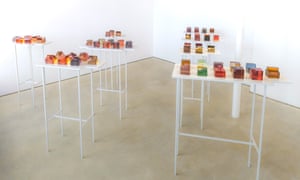
He likes the “humble, modest” shape of the caps because while they rest on the ground, the tip of the dome is reaching for the sky. He talks about how the hats look like figures in a meditative moment, like the “lotus position” and how in each group one hat is set slightly apart, as though it is leading the others in prayer.
Other works play on this theme, too. He shows me resin blocks he has created for his 2015 work, Manzil, shaped like a little house. From the side the block looks clear, but from the front it is a rainbow of coloured resin strips layered on top of each other. As with Hat Light, the plain exterior hides the internal beauty.
The Jameel prize, a biennial award, was created to showcase the continuing influence of Islamic art, craft and design on contemporary artworks. What the exhibition that accompanies it has done, says founding curator Tim Stanley (the V&A’s first ever curator for the Middle Eastern collections), is broaden the understanding about what constitutes Islamic tradition and the work it inspires. This year, the show includes pieces inspired by calligraphy and minaturism, which serve as jumping off points for abstract, unexpected work.
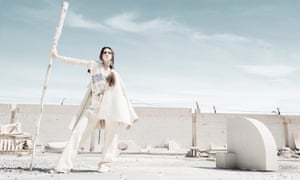
The 2018 shortlist includes the Bangladeshi architect Marina Tabassum, whose mosque in Dhaka is based on buildings from the country’s sultanate period. There is a Bahraini fashion designer, too, Hala Kaiksow, whose sustainable womenswear includes modified forms of Iranian shepherd’s coats, with pleating details inspired by Cypriot shepherd’s water bags and Islamic geometry.
Stanley points out that the London museum’s own Islamic art collection began with objects from the Great Exhibition in nearby Hyde Park of 1851, specifically picked in the hope that its excellent craftsmanship would inspire British design. The Jameel prize, Stanley says, echoes this because it is for any work influenced by Islamic art traditions – not “Islamic art”. At a time when Middle Eastern and African art has enjoyed a surge in interest, the nominees and winners for this prize can come from any religious background or country. The emphasis on cross pollination “reinforces the idea we are all connected”, says Stanley.
In Tétouan, as Rahmoun leads the way to the studio in his home, in the heart of the medina, traditional Islamic craftsmanship surrounds us. The bewitching old town was rebuilt by Andalusian refugees expelled after the reconquest of Spain in the 15th century. There are elegant, mosaic-tiled archways and behind some of the ornately studded wooden doors lie palatial family homes that curl around courtyards planted with orange and lemon trees. Some are built so close together that they have windows that open into their neighbour’s homes. Rules had to be agreed on for who had the opening rights. Even on the streets, the white and blue-washed walls press in so closely it’s easy to lose your sense of time, space and direction.
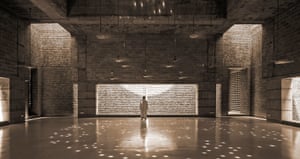
“It is like a labyrinth,” says Rahmoun. “It’s not really logical architecture, it’s more organic – like our heads and how we think.”
Unsurprisingly, he says Tétouan has always been an inspiration. He loves the way, in the medina, the “the light comes from above, there are no cars … you have to know your way around, and you discover new things all the time”.
As we arrive in his studio – which is so neat it looks as if Marie Kondo has been tidying up – it is clear just how much Rahmoun draws on this heritage. We talk about his obsession with certain numbers. “I like the numbers seven, five, three, one; odd numbers represent [to me] the beginning of eternity,” he says, grabbing a piece of paper to draw a series of dots to show how uneven numbers hint at more to come. The number 77, is a particular favourite because of an Islamic religious tradition that says there are 77 ways to practise your faith, from holding a profession of belief to clearing dangerous objects from roads.
Similarly, when he sees the opportunity, he faces his work towards Mecca. “I told myself, why not use something from my culture … it’s a beautiful image, [the fact] that you can see from the moon all my work is facing qibla” – the direction in which Muslims pray.
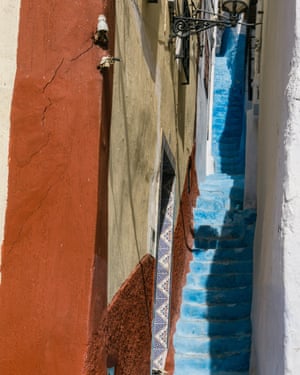
Yet he is at pains to ensure the symbols he uses are inclusive. He chose 77 over 99 – traditionally the number of names or attributes of Allah – because: “When I see the number of names of God, then I am talking about Islam and one religion – and that’s not my way. I want to talk about humanity and something we all feel.”
In Morocco’s cities, there has been something of a cultural boom in recent years, with new galleries opening up and the international art fair dedicated to African art, 1:54, making its debut in the country. Yet there is still little state funding or infrastructure for artists. In Tangier, a 90-minute drive from Tétouan, I meet Yto Barrada, whose exhibition at the Barbican in London finished last month. She lives in New York, but a decade ago she set up Cinéma Rif, then north Africa’s only arthouse cinema. She talks eloquently about the problems of setting up not-for-profit cultural enterprises in the country.
While she is away, she has allowed an artists’ collective, Atelier Kissaria, to make use of her former studio in Tangier. The collective’s project manager Amina Mourid says the city’s explosion in size, and the consequences of this rapid economic development is something that preoccupies many of the artists they work with.
Rahmoun is represented by a gallery in Paris and has an established reputation in much of Europe, if not yet in the UK. But he says he would never think of permanently leaving the town he grew up in. “When I am talking to people in Tétouan it feels different [even] from when I am in Casablanca – I feel more connected, I’m inspired by the sense of community.
“Younger people all have the same dream,” he says – to go to Europe. Many people in his own family had the same dream, he adds. “But have they found happiness? I am not sure.”